Brotherhood & Unity was released by Compass Games in 2020. It is a card-driven wargame that uses a point-to-point movement map. Those who have played other card-driven wargames will see similarities with other games of this style. However, there are some interesting game mechanics and other features that make Brotherhood & Unity an interesting and challenging game to play.
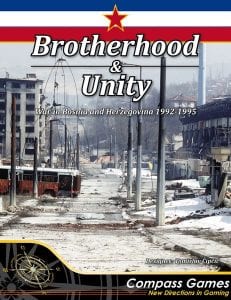
Historical Context
Before getting to those features, let’s first review the historical situation in which this conflict was fought. Some may remember specific events from this war, such as the atrocities committed against civilians and the shooting down of Captain Scot O’Grady’s F-16 and subsequent rescue mission. But sadly, many know little or nothing about this war, let alone the history of the region that has made the Balkans a powder keg for centuries. Fortunately, the designer includes a brief history in the rulebook.
A province within the Ottoman Turkish Empire, Bosnia and Herzegovina was both ethnically and religiously diverse. It included several different Slavic peoples who practiced Christianity (Slovenes, Croats, and Serbs), as well as Bosniaks [1] who were converts to Islam. After Russia defeated the Ottoman Empire in the Russo-Turkish War, administration of Bosnia and Herzegovina was turned over to the Austro-Hungarian Empire as part of a deal struck at the 1878 Congress of Berlin. By 1908, it was annexed fully into Austria-Hungary.
It was Austria-Hungary’s turn next to taste the bitter fruits of wartime defeat. As one of the Central Powers allied to Germany in World War I, Austria-Hungary was broken up by the victorious Entente powers. At first, the Balkans were divided into several different countries, but they eventually merged into a single new country, Yugoslavia. Literally meaning “Southern Slavs”, this new nation was still diverse, but politically it became increasingly dominated by Serbians. After Yugoslavia was overrun by Germany and Italy during World War II, a bitter partisan war ensued.
Some ethnic groups fought against their German and Italian occupiers under Marshal Tito’s communist forces, while others fought alongside the fascists. Tito’s forces eventually prevailed, and Bosnia Herzegovina became one of six socialist republics within communist Yugoslavia.

But as has been the case in the Balkans for centuries, this arrangement did not last long. Following the death of Tito in 1980, and the break-up of the Soviet Union in 1989, the grip of the communist party over Yugoslavia began to fail, and with it its doctrine of Bratstvo i jedinstvo (Brotherhood & Unity). Yugoslavia disintegrated into several different independent states, including Bosnia and Herzegovina. But even with this division, ethnic differences remained inside these new borders. Old grudges and animosities once again began to surface and, in the Spring of 1992, open warfare broke out between the Serbs, Croats, and Bosniaks in Bosnia Herzegovina.
This 3-sided conflict is the focus of the game, and as we’ll see, influences how players must approach the game in order to win.
Game Components
The game’s components are top notch. The mounted game board includes a map of Bosnia Herzegovina, a detailed map inset of the Sarajevo area, plus several charts, tables, and tracks. The main map is divided into regions. Indicated below the name of each region is how many total spaces and key spaces a player must control to capture that region and thus earn Strategic Will (SW) points. More on those later.
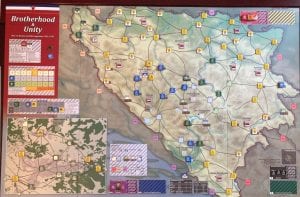
The cardboard counter playing pieces are thick and legible, and come with pre-rounded corners, so no counter clipping (trimming off the burrs after punching out the counters) is required. Each of the three player factions have standard domestic units composed of civilian reservists, elite units made up of professional soldiers who were better trained and equipped, as well as foreign units that can cross the border from outside Bosnia Herzegovina. These latter units are mostly elite but deploying them does cause you to lose points on the Foreign Attitude (FA) track.
Each player also gets a 10-sided die in their color and a 2-sided Player Aid card. Printed on good card stock, the information is laid out very well. One side contains the detailed sequence of play, and charts, tables, and other information, including victory conditions. The other side depicts a color-coded map to indicate which regions each player needs to capture to win a victory, and more useful information. Once the rules become familiar, players will rarely need to consult the rulebook because all the information needed to play can be found on their Player Aid cards.
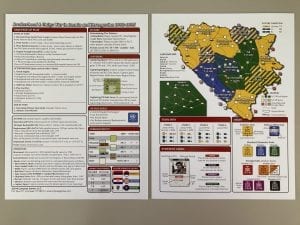
The rulebook is 32-pages in length, of which 11 contain a brief history, a detailed glossary explaining the real events behind each Strategy Card, a bibliography, images of the counter sheets, credits, and an index. So, with only about 20-pages of rules, it is on the lighter side for a wargame. It is well organized and contains numerous illustrations and examples of play.
But as with any card-driven game, the heart of the game are the cards. Unlike some other games that use a single deck for all the players, each of the three factions get their own deck. The cards are of excellent quality, containing large text that can be easily read. Some contain actual photographs from the conflict. Like most card-driven wargames, each card has a large number printed on it and event text. It can either be used for its printed value or for the event. Some events are of a specific type and can be used in a special way—for combat bonuses, to interrupt another player’s turn, to launch an offensive, or to deploy foreign units. In addition, each card is marked as either Early War, Early/Late War, and Late War which determines if they are included in the player’s draw deck on certain turns.

How the Game is Played
The game consists of 4 turns, each representing one year of the war. Each turn is divided into 3 main phases. During the Start of Turn Phase, players draw new cards from their Strategy Card deck, place reinforcements, and deploy foreign units. The number of cards each player draws, and their number of reinforcements, varies each turn. Additionally, only certain cards are included in each player’s deck depending on whether it is the Early War (turns 1 and 2) or Late War (turns 3 and 4). That means players will need to create a new draw deck at the start of turn 3.
The Action Phase is next. In player turn order as shown on the game turn record track, each player first checks the supply status of their units, and places either Low Supply or Out of Supply markers on those units that cannot trace a supply path to a supply source. Out of Supply units may also have to lose steps or even be eliminated. After supply is checked, conduct any required NATO airstrikes per the FA track. Then, in player turn order, each player plays a Strategy Card from their hand. The card can be used in 5 different ways: to conduct an operation, to strategically redeploy units, to gain replacements, to conduct a diplomatic action, or to play the card for its event.
To perform an operation, the card’s printed value is used to activate all units in that number of spaces. Each activated unit can then perform one action; move, entrench, or attack. Strategic redeployment allows the player to move the number of units indicated by the card’s value any number of connected and controlled spaces. If used to gain replacements, the player multiplies the card’s value by 2 and uses that number of replacement points to flip units on the board from their weakened reverse side to their full-strength front side and/or rebuild eliminated units and put them on the board. A diplomatic action allows the player to raise their Foreign Attitude (FA) level by 1 or 2 points, +1 FA if the card’s value is 2 or 3, or +2 FA if the card’s value is 4. Finally, the player can opt to play the card for its printed event following the instructions on the card.
Assuming none of the players have achieved an automatic victory, the End of Turn phase occurs after all Strategy Cards have been played by all three players. If it is the last turn of the game, each player computes their Victory Condition (VC) score to determine the winner. If it is not the last turn, advance the game turn marker to the next space. A player’s VC score is calculated by adding an Initial Factor (0 for the Serbs, 11 for the Croats, and 16 for the Bosniaks) to the number of Strategic Will points they have accumulated. The VC score is then lowered by 1 point for each key region that player failed to capture, and by 1 point for that player’s Interventional Level as indicated on the FA track.
Game Features
By now you’re probably asking what are some of the interesting features of this game? First and foremost, this is a 3-sided – not just a 3-player – game. While other wargames may include multiple factions or nations, they are typically fighting on one of two sides in the conflict. In Brotherhood & Unity, the Serbs, Croats, and Bosniaks are all competing against each other. While two of the sides may cooperate for a time, especially the Croats and Bosniaks early in the conflict when the Serbs have the upper hand, they will eventually have to clash to achieve their required victory conditions.
As already mentioned, each Strategy Card is designated as Early, Late, or both Early and Late War. During the first two turns, a player’s deck must contain only Early and Early/Late War cards. During the last two turns, only the Late and Early/Late War cards are used. Additionally, the number of cards each player is dealt each turn, and the turn order, changes. Even the number of reinforcements points changes from turn-to-turn. These mechanics simulate the changing fortunes of the combatants over the 4-year conflict. During the Early War, the Serbians go first, start each turn with more cards and reinforcements, and have some very powerful cards. By the Late War, the advantage swings over to the Bosniaks and Croatians.
Another interesting mechanic is the Foreign Attitude (FA) track. This simulates the reaction of NATO and the United Nations to events unfolding on the ground. Capturing key spaces is needed to take over regions and achieve victory. But every time you do so, you will lose 1 point on the FA track because of the refugee crisis you create. Likewise, bringing in foreign units from outside the country and capturing UN safe spaces will also cause you to lose FA points. Certain cards have events on them that can raise or lower players’ FA points too.
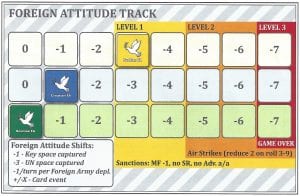
Once your FA marker reaches Level 1, sanctions are imposed that reduce you units’ movement factor, prevent you from redeploying units from one part of the board to another, and from advancing after an attack. This simulates fuel supplies being cut off by the outside world. Reach Level 2 on the FA track and you begin to be subjected to NATO air strikes. If you reach Level 3, NATO conducts a full-scale military intervention. This ends the game immediately and you lose regardless of how many victory points you have.
The other major feature that affects game play is the Strategic Will (SW) track. Each player starts the game with a different number of SW points. The number of SW points indicates to what degree you have fulfilled your victory conditions and thus your willingness to continue fighting. Consequently, if your SW falls to zero, you have surrendered and automatically lose. On the other hand, if you accumulate the number of SW points required by your faction’s unique victory conditions, you could achieve an immediate victory and win the game.

As with the FA track, you can gain or lose SW points during the game. The number of SW points is affected by capturing or losing regions and key spaces, by eliminating or losing units in combat, or by the play of certain card events. But you will not obtain an automatic victory through SW points alone. To do that, you must also capture all the regions shown on the Player Aid card for your faction. This will be exceedingly difficult, as was the case in real life.
Finally, there is the combat system. Rather than using the typical odds-based combat results table, it uses a system based on combat and loss factors. Each player begins by totaling the number of combat factors (CF) involved. Out of supply units have their CF reduced by half. Then starting with the attacker, each player can play one combat card from their hand for the event printed on the card. Finally, each player rolls their die, applying any die roll modifications from the cards played, terrain effects, and entrenchments, to determine their combat effectiveness (CE). Each player multiples their CF by their CE to determine the Loss Number inflicted on the other player.
The Loss Number is then compared to the Loss Factor (LF) printed on the other player’s units. If the Loss Number is equal to or greater than the LF of one or more units, then units will take step losses. For each step loss, a full-strength unit is flipped to its reduced side or a reduced-strength unit is eliminated. But if the Loss Number is less than the LF of every unit, then no step losses are taken. Furthermore, each player must fulfill as much of their Loss Number as possible. Therefore, if the total Loss Number is 15, and a player has two reduced-strength units each with an LF of 6, and one full-strength unit with an LF of 7, then the 7 LF unit must take two step losses (for a total of 14) and be eliminated. This means players will have to carefully plan each attack to maximize their chance of inflicting step losses on their opponent.
Impressions
While some of the mechanics and features in this game are not necessarily unique, they have been seamlessly interwoven to create a richly rewarding and nuanced game. Like most card-driven wargames, Strategy Cards are your key resource. You want to use them efficiently to obtain the maximum benefit. In Brotherhood & Unity, that means capturing regions to raise your Strategic Will while also eliminating enemy units and avoiding losses of your own. However, you must constantly keep your eye on the FA track. Be too successful too quickly and you may find yourself dealing with UN sanctions or NATO airstrikes. Players will find they have to carefully plan the sequence they play their cards, not only to achieve their victory conditions, but to reduce their FA level before it gets too high. It is this interplay between the SW and FA tracks that makes this game such a fun puzzle.
The way the board is designed also creates interesting problems because it is not simply a case of capturing spaces. To gain SW points, you must capture key spaces, and more importantly, regions. You may control 6 of the 7 spaces in a region, but if that 7th space is a key space, you haven’t captured the region. Furthermore, 60% of the key spaces are in mountains or cities which impose a -2 and -4 die roll modifier, respectively, on the attacker. Some key spaces are partially behind rivers. If all the attackers are crossing river borders, not only is there a -4 die roll modifier, but the defender gets to fire first. This could cause step losses on the attacker and reduce the player’s combat factors before they can even roll their die. These considerations will influence your axes of advance and how you position your units to capture a region with the least effort possible.

The inclusion of the foreign units and spaces also creates some interesting possibilities. For example, take the situation depicted here in the Cazinska Krajina region in the extreme northwest. While the Serbs (yellow) have amassed six full strength VRS brigades to attack Bosanska Krupa (indicated by the red arrows), they would all be attacking across a river – the heavy blue border on the south and east of the space. Although the key space of Bihac is more lightly defended, launching an attack against it is also daunting since there is only one Serb occupied space in Bosnia Herzegovina adjacent to it and the Serb player lacks a combat card to offset the -4 die roll modifier for a river defense. What to do?
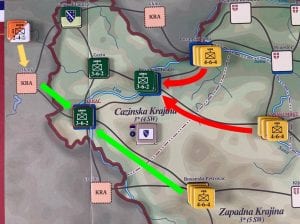
The key to capturing the region is to use the KRA spaces in neighboring Croatia. The Serbs can first play the Inter-Bosniak War card to deploy the two NOZB brigades into Slunj (indicated by the yellow arrow). Note that per the card’s text it does NOT affect the Serbian FA level. On their next action, they could then attack Bihac from both Bosanski Petrovac and Slunj (the green arrows). Because the NOZB brigades are not attacking across a river border, the Bosniak player’s river defense bonus is negated. It also increases the number of attacking combat factors. A die roll of 3 or higher will result in a Loss Number of 16 and eliminate the lone unit in Bihac and allow the 3 full-strength VRS brigades to advance into the space. On their next action, the Serbs could attack Cazin from Bihac. If successful, the Serbs would meet the requirements for capturing Cazinska Krajina and gain a total of 9 SW points (4 for capturing Cazinska Krajina, 3 for capturing Bihac, and 2 for eliminating the units in Bihac and Cazin).
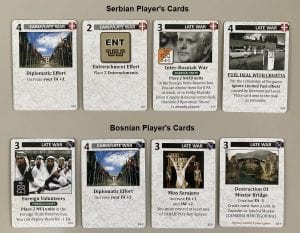
Of course, such carefully laid plans could easily go awry depending on what the Bosniak player does in response to the Inter-Bosniak War card. Fortunately for the Serbs, the Bosniaks have no Interrupt or Combat cards in their hand that could alter the situation. Their only option would be to play a card for replacements and beef-up their defenses in the region. However, there is no line of supply from Cazinska Krajina to a supply source (a CRO space). While Bihac acts as a limited source of supply, as do all key spaces, since it is the only key space in the area only 1 replacement point can be gained. Adding a single reduced-strength brigade to Cazin will likely not prevent its fall.
The game is chock full of move and counter move situations like this. And because there are 3 players, you will often find that your offensive plans against one opponent must be interrupted to deal with a crisis created by the other opponent on another front. I n many respects, it is very much like a game of chess, only better because you’re learning history and dealing with realistically complex issues that the actual combatants might have faced.
Summary
By now it should be no surprise that I really like this game. In fact, it has vaulted into my number one slot of card-driven wargames. The 3-player dynamic and interaction between the game’s systems, coupled with great components, easy-to-learn rules, and a modest playing time of 2-3 hours means Brotherhood & Unity will find itself on my gaming table often.
Another aspect of the game I like is that all three sides must play aggressively to win. If you simply play defense, you may be able to prevent the other players from achieving their automatic victory conditions. But in all likelihood you will not accumulate enough victory points of your own to win by the end of the game. This means you must go on the offensive to take key spaces and regions, while also holding on to your own territory, keeping your losses low, and not allowing your FA level to get out of hand. It’s a delicate balancing act and a very interesting strategic problem to solve.
The only thing I can criticize are a few cases of ambiguity in the rules. Fortunately, the designer is very active on BoardGameGeek and answers questions promptly. He even posted a video on how to pronounce the place names on the map.
Before going out and buying this game you should consider whether you can find two other people to play this game with. While it can be played with only two players, with the Serbs on one side and the Croats and Bosniaks on the other, it takes away the 3-sided struggle with all it’s deal-making and potential back-stabbing. Not only is this true to history, but adds another dimension to the game. So if you can find two other players, you won’t regret your purchase.
The final verdict is in. This is a fascinating and immensely enjoyable game. Yes Mr. Cipcic, your game is good. Very good.
[1] In keeping with the designer’s custom, I’ve used the term Bosniak rather than Bosnian. As I learned, a Bosnian can be anyone who is from Bosnia Herzegovina, whereas a Bosniak is a Bosnian Muslim. That is the group represented in the game.


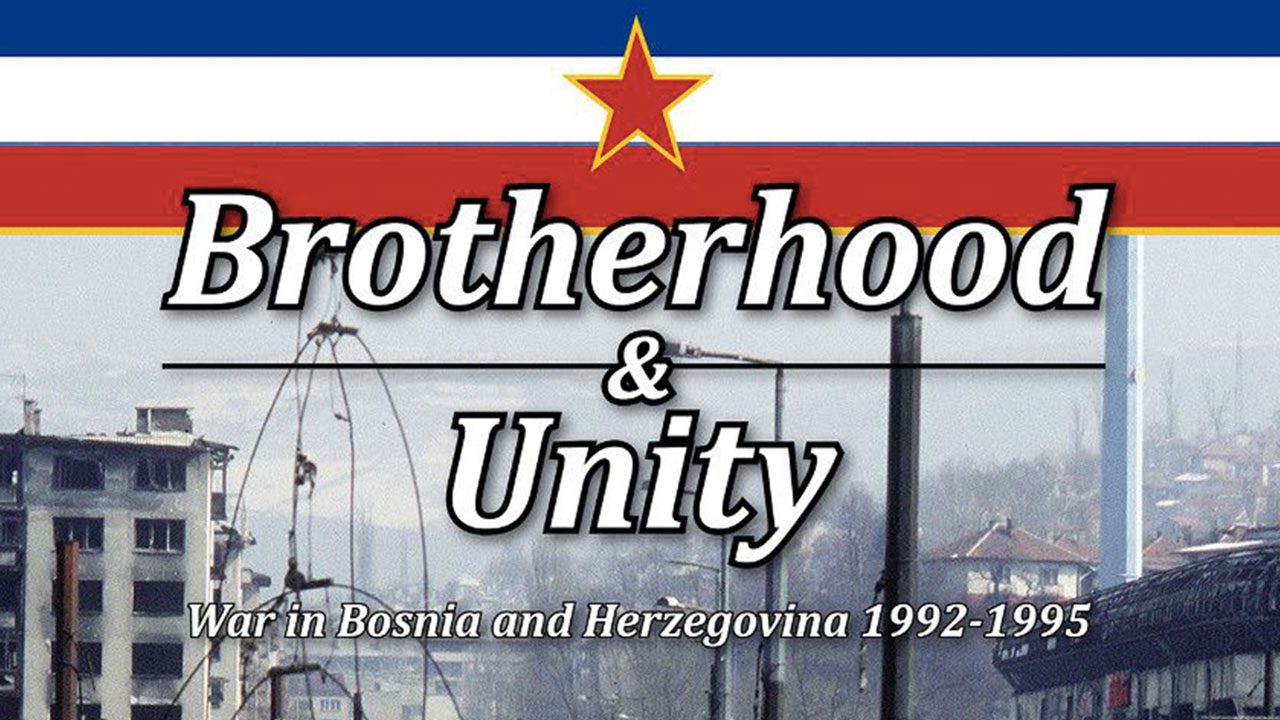

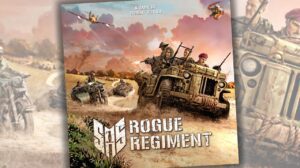







Add Comment